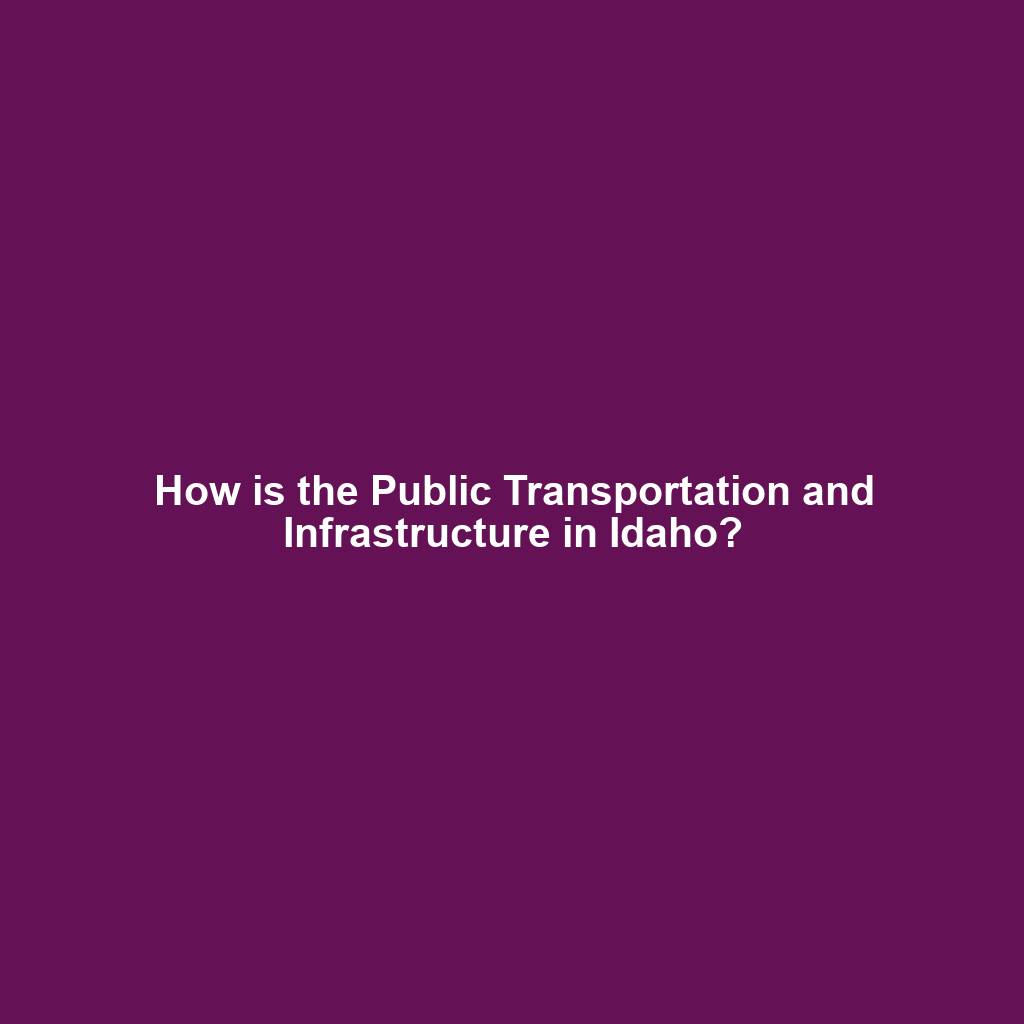How is the Public Transportation and Infrastructure in Idaho?
Idaho, known for its stunning natural beauty and outdoor recreation opportunities, faces challenges and opportunities in developing and maintaining its public transportation and infrastructure. This comprehensive analysis will explore the current state of public transportation, roads, bridges, and other infrastructure in Idaho, highlighting areas for improvement and outlining potential solutions.
Public Transportation in Idaho: A Snapshot
Public transportation in Idaho is limited, particularly outside the major metropolitan areas. The largest city, Boise, has a modest bus system that primarily serves the downtown area and surrounding suburbs. Other cities, such as Pocatello and Idaho Falls, have limited public transportation options, primarily consisting of dial-a-ride services. The lack of comprehensive public transportation poses challenges for residents without access to private vehicles, especially those in rural areas or with mobility impairments.
Road Conditions in Idaho: A Mixed Picture
Idaho’s road network spans over 65,000 miles, connecting cities, towns, and rural communities. While some roads are well-maintained, others are in need of repair or expansion. Major highways, such as I-84 and I-90, are generally in good condition, but secondary roads and bridges can be problematic, especially during winter months. Rural areas face challenges with road maintenance due to limited funding and a dispersed population. The state is actively working to address road infrastructure needs, with ongoing projects to improve road conditions and enhance safety.
Bridges in Idaho: A Critical Concern
Idaho’s bridge infrastructure requires significant attention. Many bridges are aging and in need of repair or replacement. According to the Federal Highway Administration, nearly 10% of Idaho’s bridges are classified as structurally deficient or functionally obsolete. This poses safety concerns and can disrupt traffic flow. The state has identified bridge repair and replacement as a priority, but funding remains a challenge.
Other Infrastructure Needs in Idaho
Beyond public transportation, roads, and bridges, Idaho has other infrastructure needs. The state’s energy grid, for example, faces challenges in meeting the growing demand for electricity. Idaho is also working to expand broadband access, especially in rural areas, to improve connectivity and economic development. Additionally, Idaho’s water infrastructure, including dams, reservoirs, and irrigation systems, requires investment to ensure a reliable water supply for communities and agriculture.
Addressing Infrastructure Challenges in Idaho
Addressing Idaho’s infrastructure challenges requires a multifaceted approach. The state is working to secure funding from both federal and state sources, including through the Infrastructure Investment and Jobs Act passed in 2021. Idaho is also exploring innovative financing mechanisms, such as public-private partnerships, to supplement traditional funding sources. Additionally, the state is prioritizing projects that will improve safety, enhance economic development, and promote sustainability.
Conclusion
Idaho’s public transportation and infrastructure face challenges, but also present opportunities for improvement. By investing in public transportation, maintaining and expanding road networks, repairing and replacing bridges, and addressing other infrastructure needs, Idaho can enhance the quality of life for its residents, boost economic growth, and ensure a sustainable future.
Addressing Infrastructure Challenges in Idaho
Addressing Idaho’s infrastructure challenges requires a multifaceted approach. The state is working to secure funding from both federal and state sources, including through the Infrastructure Investment and Jobs Act passed in 2021. Idaho is also exploring innovative financing mechanisms, such as public-private partnerships, to supplement traditional funding sources. Additionally, the state is prioritizing projects that will improve safety, enhance economic development, and promote sustainability.
Investing in Public Transportation
Expanding public transportation options in Idaho is crucial for improving mobility and reducing traffic congestion. The state is working to develop a comprehensive public transportation plan that will identify areas with the greatest need and explore funding options for new bus routes, light rail systems, and other transportation modes. By investing in public transportation, Idaho can make it easier for residents to get around, reduce air pollution, and create a more livable and sustainable state.
Maintaining and Expanding Road Networks
Idaho’s road network is essential for connecting communities and supporting economic growth. The state is committed to maintaining and expanding its road system, with a focus on improving safety and efficiency. This includes projects to widen highways, add passing lanes, and improve intersections. Idaho is also working to address the challenges of rural roads, which often face funding and maintenance issues. By investing in its road network, Idaho can ensure a safe and reliable transportation system for all residents.
Repairing and Replacing Bridges
Idaho’s aging bridge infrastructure poses a significant safety concern and can disrupt traffic flow. The state has identified bridge repair and replacement as a top priority and is working to secure funding for these projects. Idaho is also exploring innovative construction techniques and materials to reduce the cost and time required for bridge repairs. By investing in its bridges, Idaho can ensure a safe and efficient transportation system for years to come.
Addressing Other Infrastructure Needs
Beyond public transportation, roads, and bridges, Idaho has other infrastructure needs. The state’s energy grid, for example, faces challenges in meeting the growing demand for electricity. Idaho is working to develop new energy sources, such as solar and wind power, and to improve the efficiency of its energy grid. Idaho is also working to expand broadband access, especially in rural areas, to improve connectivity and economic development. Additionally, Idaho’s water infrastructure, including dams, reservoirs, and irrigation systems, requires investment to ensure a reliable water supply for communities and agriculture.
Conclusion
Idaho’s public transportation and infrastructure face challenges, but also present opportunities for improvement. By investing in public transportation, maintaining and expanding road networks, repairing and replacing bridges, and addressing other infrastructure needs, Idaho can enhance the quality of life for its residents, boost economic growth, and ensure a sustainable future.
The state is committed to working with federal, state, and local partners to secure funding and implement innovative solutions to address these challenges. Idaho is well-positioned to become a leader in transportation and infrastructure, creating a more prosperous and livable state for all.

